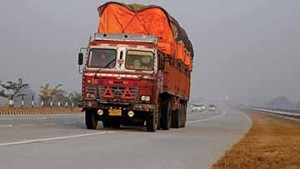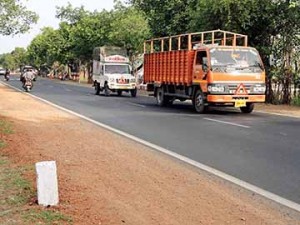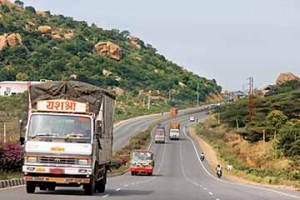Logistics will play an increasingly crucial role in India’s development. There are however challenges to be overcome.
Story by: Team CV
Logistical needs in India are on the rise. The proliferation of ecommerce is one of the many reasons that is providing the thrust. Long way to go, logistics in India, has many challenges to deal with. According to the World Economic Situation and Prospect report for 2016, India is expected to achieve a 7.5 per cent GDP growth in 2017 and the economic prospects of the South Asian region will be ‘contingent’ on the growth trajectory of India and Iran. With the government driving initiatives like ‘Make in India’, which are aimed at boosting the manufacturing sector among others, the need for a better logistical support is becoming all the more essential. The observation of P S S Prasad, President, Apollo Logisolutions, that logistics will have a greater role to play in the growth (of the country) with initiatives such as Make in India, assumes importance at this point in time. Stressing on the fact that the state of infrastructure in the country is poor and a big challenge, Prasad is also known to have said that ecommerce will spur growth in the logistics sector as these companies need to deliver products efficiently in the remotest corner of the country. Claimed an industry expert that despite an extensive rail network, and rising air network, it is the road network that continues to play a major role in the rise of logistics. Challenges therefore, he stated, is the need for road connectivity to the remotest areas of the country where ecommerce has already reached over the internet. The ecommerce sector is estimated to be worth USD 220 billion in India by 2025. It is growing at an electric pace for certain.
Ecommerce logistical challenges
Medium and heavy commercial vehicles continue to grow on replacement demand. Light commercial vehicles have also began to record growth, albeit at a slower pace than the big rigs. There is a distinct shift towards higher tonnage vehicles throughout the segments. Reflecting upon further strengthening of the hub and spoke transportation model, it is clear that fleets are looking at operating efficiency and a faster turnaround time. GST is still some distance away, and for it to abolish state borders and the time lost there will take time. With the price of the modern trucks higher than the ones they replace, the expectations of fleet operators and transporters are changing. This is having a definite effect on the logistics sector and specifically ecommerce logistics. With the government keen to regulate the ecommerce industry, logistics is one area where the opportunity to streamline efficiency and costs is visible.
The announcement of building 20 km of road per day by the minister of road transport and highways, Nitin Gadkari, is welcome. It, shows that the government is keen. Road network is however an activity that involves state governments too. With different aspects of the logistics industry falling under different ministries, and which would lead to an amount of inefficiency, it is clear that ecommerce may have much to look at in terms of enhancing efficiency. Especially that of its logistics operations. Constantly changing federal tax structures are a problem no doubt. Newer technologies are being adopted by players in the field but the impact is not as much as it should have been. Fleets are investing in new trucks; containerisation is on the rise. The fundamental infrastructure, however continues to be weak. And, over the long term, there will be a need for investment to be made in automation while making the most of existing resources. Players like Rhenus are pushing for palletised transportation, but the response as of now is limited to a few oil companies. In the case of urban landscape, the arrival of new, efficient small commercial vehicles is proving to be of good support to the ecommerce companies. Constraint however remains in terms of infrastructure.
Making the most of the existing resources
India is a vast country and with a strong consumption potential. Considering the potential there is not enough road, rail and air connectivity. To make the most of the existing resources, there is a need to look into the time, energy and resources spent on doing the work of logistics in India. It would be conserved if the infrastructure was up to the standards of some countries that are doing well in this arena. If the ‘Make in India’ initiative achieves even half of what it is expected to achieve, an amount of strain will be put on the Indian logistics structure. There’s little doubt that only a few companies are equipped with the requisite skill set to offer complex project logistics services. The ability to load, lash, survey and plan the route are some of the unique areas of specialisation that are necessary to successfully offer complex project logistics services. The use of telematics in trucks and fleets is growing. There is however a huge potential for growth, both in terms of route planning, tracking and operation efficiency. According to Ravi Pisharody, Executive Director – Commercial Vehicles, Tata Motors, the new Signa range of trucks will have telematics as standard. Commercial vehicle manufacturers like Volvo Eicher and Mahindra are also pushing telematics in a big way. For that matter, all truck companies are pushing telematics, and for a good reason. Even private playres that specialise in telematics are offering innovative solutions. Bangalore-based Infotrack, for example, is marketing a new initiative in telematics. The need for a sound basic infrastructure remains. This is especially evident in the areas that involve the use of purpose-built, heavy machinery, which often needs to be imported. High capital investment is required, and is limited by scope due to the logistical constraints.
Need for a robust infra for ODC logistics
The handling of heavy, over-dimensional cargo is a particularly lucrative business for existing and prospective logistics players in India. Global and domestic firms such as DB Schenker, Bertling Logistics, Allcargo Global Logistics and Transport Corporation of India have well embedded themselves in the field. Challenges are many. Poor overall road infrastructure, especially for connectivity to remote locations, has made cargo movement very risky, endangering the cargo, equipment used to move it, people working on the operation, and general public. The lack of efficient documentation and approval procedures in several ministries and state departments continues to be a hindrance claimed an industry source. He also drew attention towards other hindrances, which include customs clearance delays, tardy approvals from highway authorities and the lack of timely cooperation among stakeholders involved in the project logistics operations process. Proposals for mass rapid transport system projects in India are on the rise, and could create a space for niche project logistics service providers. Providers who have the best-suited equipment and a mix of expertise to offer the required logistics services.
Third party logistics
The concept of third party logistics is at a nascent stage in India. Expected to help manufacturers to achieve the strategic objectives by concentrating more on core competency of the main business, third party logistics, in India, which spends 13 per cent of its GDP on logistics compared to an average of 10 per cent in developed countries, are divided along two lines – an asset based model that consists of assets like trucks, distribution centers and warehouses, and a non-asset based model. An important tool to enhance the customer satisfaction and to integrate the different processes of supply chain by using advanced tools of information technology, third party logistics initiated the green supply chain management approach, and is set to grow subject to a change in the tax structure. The current fed-rated tax structure is claimed to be a deterrent in the proliferation of third party logistics.
Sector growth
The logistics sector in India is claimed to be growing at a rate of 15 per cent as of current. Set to play an important role in the success of ambitious initiatives like ‘Make in India’, logistics is set to gain from the special focus on roads since a vast majority of logistics work in India is done via roads. Rail comes second despite India having the largest rail network in the world. Investment in rail is up, and may lead to changes. As of current, the stress lies on road network. For the logistics sector to experience a strong growth much would depend upon the quantum of investment from the private sector, government regulation, and an investment in infrastructure. If the arrival of transport apps. that promise to enhance connectivity between the transporter-operator and the customer is a positive development and reflects upon the rising clout of ‘Internet of Things’, logistics, performing well over the last few years, it is evident, has some distance to go.






















